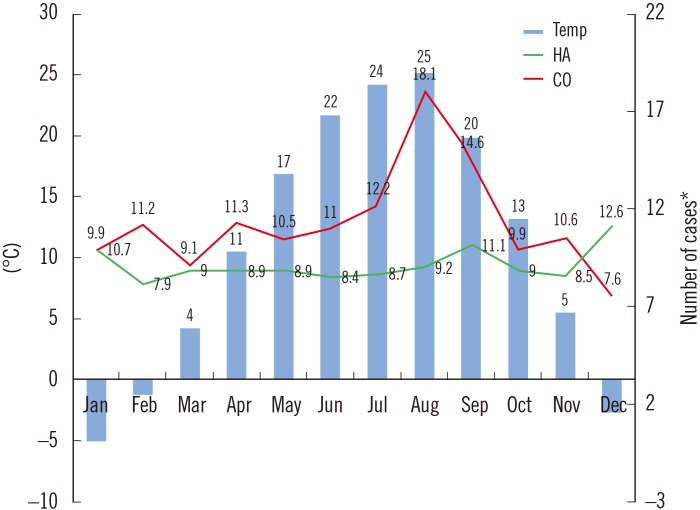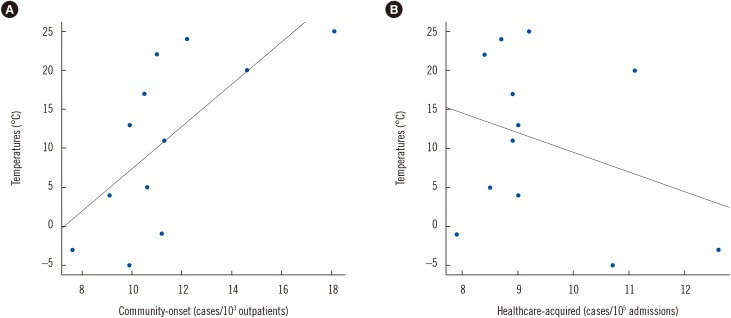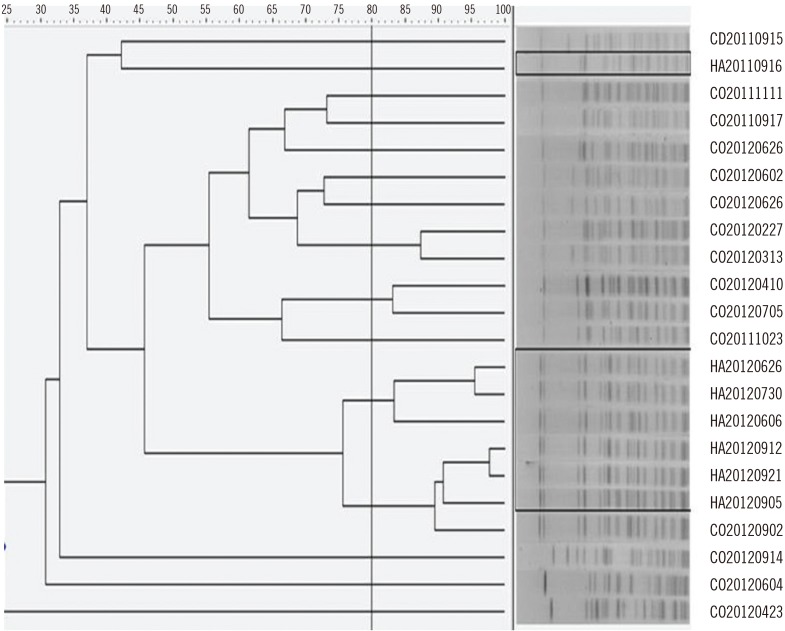Ann Lab Med.
2018 May;38(3):266-270. 10.3343/alm.2018.38.3.266.
Seasonal and Temperature-Associated Increase in Community-Onset Acinetobacter baumannii Complex Colonization or Infection
- Affiliations
-
- 1Department of Laboratory Medicine, National Health Insurance Service Ilsan Hospital, Goyang, Korea.
- 2Department of Laboratory Medicine, Inha University College of Medicine, Incheon, Korea.
- 3Department of Laboratory Medicine, Yonsei University College of Medicine, Seoul, Korea. leekcp@yuhs.ac
- 4Research Institute of Bacterial Resistance, Yonsei University College of Medicine, Seoul, Korea.
- KMID: 2403462
- DOI: http://doi.org/10.3343/alm.2018.38.3.266
Abstract
- Identifying the trends in community-onset Acinetobacter baumannii complex isolation and diversity according to temperature could help provide insight into the behavior of the A. baumannii complex. We performed a retrospective analysis of A. baumannii complex (Acinetobacter baumannii, Acinetobacter nosocomialis, Acinetobacter pittii, and Acinetobacter calcoaceticus) isolates obtained from patients at a Korean community hospital from 2006 to 2015 with reference to seasonal temperatures. The incidence rates were compared between warm (June-September) and cold (November-March) months, defined as an average mean temperature ≥20℃ and ≤5℃, respectively. Incidence rate was calculated as the number of cases per month, converted to cases/10âµ admissions for healthcare-acquired isolates and cases/10³ outpatients for community-onset isolates. Approximately 3,500 A. baumannii complex cases were identified, and 26.2% of them were community-onset cases. The median (interquartile range) number of community-onset A. baumannii complex cases was significantly higher (P=0.0002) in warm months at 13.8 (9.5-17.6) than in cold months at 10.1 (6.3-13.2). There was a strong correlation between community-onset A. baumannii complex cases and temperature (Pearson's r=0.6805, P=0.0149). Thus, we identified a seasonality pattern for community-onset A. baumannii complex colonization or infection, but not for healthcare-acquired cases.
MeSH Terms
Figure
Cited by 2 articles
-
Active Surveillance for Carbapenem-resistant
Enterobacteriaceae at a Single Center for Four Years
Inho Choi, Yangsoon Lee
Ann Lab Med. 2022;42(3):367-369. doi: 10.3343/alm.2022.42.3.367.Season and Temperature Effects on Bloodstream Infection Incidence in a Korean Tertiary Referral Hospital
Young Suk Sohn, Jung-Hyun Byun, Young Ah Kim, Dong Chun Shin, Kyungwon Lee
Ann Clin Microbiol. 2020;23(1):33-43. doi: 10.5145/ACM.2020.23.1.33.
Reference
-
1. Perencevich EN, McGregor JC, Shardell M, Furuno JP, Harris AD, Morris JG Jr, et al. Summer peaks in the incidences of gram-negative bacterial infection among hospitalized patients. Infect Control Hosp Epidemiol. 2008; 29:1124–1131. PMID: 19031546.2. Eber MR, Shardell M, Schweizer ML, Laxminarayan R, Perencevich EN. Seasonal and temperature-associated increases in gram-negative bacterial bloodstream infections among hospitalized patients. PLoS One. 2011; 6:e25298. PMID: 21966489.3. Richet H. Seasonality in Gram-negative and healthcare-associated infections. Clin Microbiol Infect. 2012; 18:934–940. PMID: 22784293.4. Retailliau HF, Hightower AW, Dixon RE, Allen JR. Acinetobacter calcoaceticus: a nosocomial pathogen with an unusual seasonal pattern. J Infect Dis. 1979; 139:371–375. PMID: 448188.5. Fukuta Y, Clarke LG, Shields RK, Wagener MM, Pasculle AW, Doi Y. Lack of seasonality in the occurrence of multidrug-resistant Acinetobacter baumannii complex. Infect Control Hosp Epidemiol. 2012; 33:1051–1052. PMID: 22961027.6. Friedman ND, Kaye KS, Stout JE, McGarry SA, Trivette SL, Briggs JP, et al. Health care-associated bloodstream infections in adults: a reason to change the accepted definition of community-acquired infections. Ann Intern Med. 2002; 137:791–797. PMID: 12435215.7. Lee K, Yong D, Jeong SH, Chong Y. Multidrug-resistant Acinetobacter spp.: increasingly problematic nosocomial pathogens. Yonsei Med J. 2011; 52:879–891. PMID: 22028150.8. Lee Y, Kim YA, Song W, Lee H, Lee HS, Jang SJ, et al. Recent trends in antimicrobial resistance in intensive care units in Korea. Korean J Nosocomial Infect Control. 2014; 19:29–36.9. Yang HY, Lee HJ, Suh JT, Lee KM. Outbreaks of imipenem resistant Acinetobacter baumannii producing OXA-23 beta-lactamase in a tertiary care hospital in Korea. Yonsei Med J. 2009; 50:764–770. PMID: 20046415.10. Ratkowsky DA, Lowry RK, McMeekin TA, Stokes AN, Chandler RE. Model for bacterial culture growth rate throughout the entire biokinetic temperature range. J Bacteriol. 1983; 154:1222–1226. PMID: 6853443.11. Raetz CR, Reynolds CM, Trent MS, Bishop RE. Lipid A modification systems in gram-negative bacteria. Annu Rev Biochem. 2007; 76:295–329. PMID: 17362200.12. Dexter C, Murray GL, Paulsen IT, Peleg AY. Community-acquired Acinetobacter baumannii: clinical characteristics, epidemiology and pathogenesis. Expert Rev Anti Infect Ther. 2015; 13:567–573. PMID: 25850806.13. Eveillard M, Kempf M, Belmonte O, Pailhoriès H, Joly-Guillou ML. Reservoirs of Acinetobacter baumannii outside the hospital and potential involvement in emerging human community-acquired infections. Int J Infect Dis. 2013; 17:e802–e805. PMID: 23672981.14. Oh YJ, Song SH, Baik SH, Lee HH, Han IM, Oh DH. A case of fulminant community-acquired Acinetobacter baumannii pneumonia in Korea. Korean J Intern Med. 2013; 28:486–490. PMID: 23864808.15. Center for Climate and Energy Solutions. South Korea and climate change. last accessed 16 June 2017. http://www.c2es.org/international/key-country-policies/south-korea.
- Full Text Links
- Actions
-
Cited
- CITED
-
- Close
- Share
- Similar articles
-
- Successful Treatment of Acinetobacter Baumannii Meningitis with Colistin
- Clinical and Economic Evaluation of Multidrug-Resistant Acinetobacter baumannii Colonization in the Intensive Care Unit
- Clinical Features of Acinetobacter Baumannii Keratitis
- Carbapenem-Resistant Acinetobacter baumannii
- Association of biofilm production with colonization among clinical isolates of Acinetobacter baumannii




